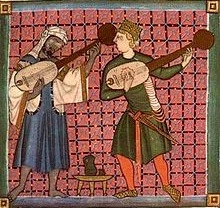
In WomenSing’s upcoming concert, “EarthRise,” we will consider our planet, how we treat it, and how we treat each other as we share our lives upon it. The concert features music from a variety of traditions, including the Persian-inspired Songs from Behind the Caravan: Songs of Hâfez by composer Abbie Betinis. Accompanying us on the Oud, an instrument with ancient Persian roots, we are thrilled to welcome Gari Hegedus.
Gari is a widely sought after, highly accomplished, and versatile recording and performing artist. He performs on a wide range of traditional instruments, including Oud, violin, Turkish Saz, Yayli Tambor, Irish pennywhistle, Mandocello, and flute. He began his musical career in his twenties, playing Celtic music on the mandolin and fiddle. He owned a music store in Portland, Oregon, for ten years, which became a Celtic music center and a venue for world music concerts. His musical direction changed after a friend loaned him an Oud and he began lessons with a Kuwait-born teacher at Portland State University. The Oud eventually led him to the Bay Area, which offers more opportunities to play Middle Eastern music. Garitoured with the Mevlevi Dervish Order of America for several years, and continues to participate in Turkish ceremonial and devotional gatherings around the country. As a composer and performer, Gari has developed the art of taksim (improvisation) to a deeply soulful level for which he has become highly recognized. He also is the only person in the Bay Area who repairs the Oud.
What is an Oud? The Oud (from the Arabic “al-ut,” meaning “thin wood”), ancestor to the lute, is a stringed instrument thought to have originated over 3,500 years ago in Persia. It is believed to be a derivation of the Persian barbat, which, in turn, is thought to stem from the Indian lute- type vīnā. In Pre Islamic Arabia and Mesopotamia, the oud consisted of three strings, with a small sound box, a long neck, and no keys (such as we see on a modern guitar). During the Islamic era, the sound box was enlarged, and another string and the key base was added. In modern times, the number of strings can increase to as many as seven. The Oud was introduced into Europe by the Moors during their conquest and occupation of Spain (711-1492), where the name became “lute.” In contrast to the western lute, the Oud has no frets and a smaller neck. The lute in turn gave birth to a much more familiar instrument—as Gari puts it, “The oud is the grandmother of the guitar.”
Gari tells us the Oud is central to most ensemble music in the Middle East, and is still evolving to find a home in music across many cultures and geographical boundaries. Come hear WomenSing and Gari in June as we celebrate the diversity of life on our planet Earth
Written by Laura Fischer
Picture from the 13th century Cantigas de Santa Maria manuscript, depicting a European musician and a Moorish musician playing similar but not identical lute/oud like instruments:









